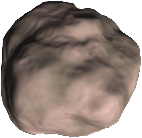Moon
A moon or natural satellite is a celestial body which orbits another larger celestial body which isn't a star. While in real-world a variety of types of bodies have moons, only the five largest planets in Kerbal Space Program have moons predefined by the game. It is possible to add additional moons using dynamically generated asteroids.
Irregularity
Moons are either defined as regular moons or irregular moons depending on the orbital characteristics. Most of them are regular moons, because their orbits have a low eccentricity and inclination. The moons Gilly, Bop and Pol are the most irregular predefined moons. It should be noted that this differentiation is made by observations and are not officially documented in the game. There is no difference between them and other celestial bodies in terms of game mechanics.
There are various properties to differentiate between both types and the properties are opposing. For example regular moons have a low eccentricity while irregular moons have usually high eccentricities. Apart from the eccentricity irregular moons have also high inclinations, a low mass ratio to the body they orbit and are uneven. Generally irregular moons have also a lower mass than their regular counterparts which results in a lower surface gravity, although they are smaller. Sometimes there is a ratio between the sphere of influence and semi-major axis mentioned, which is the same as the mass ratio raised to the power of ⅖.

The moons Gilly, Bop and Pol are considered irregular moons, because most of the defining properties are distinctly different than those of the regular moons.
Because it is believed in the real-world science that most irregular moons are captured asteroids, they are sometimes called captured asteroids. But they are different with dynamically generated asteroids which were captured, because dynamically generated asteroids are even smaller than predefined ones, and subject to the games physics system.[1] They also don't have a gravitational field, which makes them different from moons in terms of celestial mechanics.
Moon comparison
The following table shows those properties for all moons, with irregular moons highlighted. For the mass ratio, eccentricity and unevenness all irregular moons are grouped together and the difference to the closest regular moon is easily observable. Only the regular moon Ike has a higher inclination. Another regular moon Minmus has a smaller radius, lower mass and surface gravity than Bop. The unevenness is the quotient of the highest point divided by the radius. An unevenness of 0.01 means, that the highest mountain is as high as 1% of the complete radius (if the highest point data isn't complete the unevenness value is denoted as n/a).
| Moon | Radius (km) | Mass (kg) | Mass ratio | Eccentricity | Inclination (°) | Unevenness | Surface gravity (m/s²) |
|---|---|---|---|---|---|---|---|
| |
13.00 | 1.2420×1017 | 0.00000100 | 0.550 | 12.00 | 0.4923 | 0.05 |
| |
200.00 | 9.7599×1020 | 0.01844440 | 0.000 | 0.00 | 0.0353 | 1.63 |
| |
60.00 | 2.6458×1019 | 0.00050000 | 0.000 | 6.00 | 0.0954 | 0.49 |
| |
130.00 | 2.7822×1020 | 0.06161460 | 0.030 | 0.20 | n/a | 1.10 |
| |
500.00 | 2.9397×1022 | 0.00694440 | 0.000 | 0.00 | n/a | 7.85 |
| |
300.00 | 3.1088×1021 | 0.00073440 | 0.000 | 0.00 | 0.0266 | 2.31 |
| |
600.00 | 4.2332×1022 | 0.01000000 | 0.000 | 0.03 | n/a | 7.85 |
| |
65.00 | 3.7261×1019 | 0.00000880 | 0.235 | 15.00 | 0.3347 | 0.59 |
| |
44.00 | 1.0814×1019 | 0.00000260 | 0.171 | 4.25 | 0.1271 | 0.37 |
See also
- Category:Moons, containing all articles about the moons
- Natural satellite on Wikipedia
- Asteroid capture on Wikipedia
References
- ↑ “Asteroid Redirect Mission - The FAQ” by Rowsdower released on March 14th

